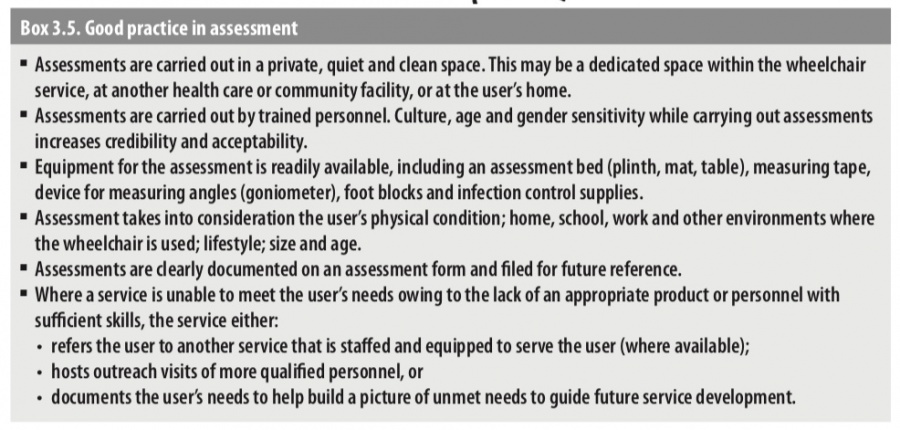Wheelchair Assessment: Difference between revisions
No edit summary |
No edit summary |
||
| Line 9: | Line 9: | ||
Assessments should always be carried out in a clean, quiet space, which may be a space within the wheelchair service, at another health care or community facility, or at the user’s home. If it is necessary to check whether a person has a pressure sore, do this in a private space. Respect the dignity and privacy of the wheelchair user irrespective of their age, gender, religion or socioeconomic status. | Assessments should always be carried out in a clean, quiet space, which may be a space within the wheelchair service, at another health care or community facility, or at the user’s home. If it is necessary to check whether a person has a pressure sore, do this in a private space. Respect the dignity and privacy of the wheelchair user irrespective of their age, gender, religion or socioeconomic status. | ||
The objective of good assessment practice is to accurately assess the needs of each individual user in order to prescribe the most appropriate wheelchair available. Every user requires an individual assessment, carried out by a person or persons with the appropriate skills. The assessment should be holistic, taking into account the lifestyle, living environment and physical condition of the user. It is important that the user and, if appropriate, the family are fully involved in the assessment. Depending on the complexity of the needs, the assessment process can take up to 2 hours and should incorporate the following | The objective of good assessment practice is to accurately assess the needs of each individual user in order to prescribe the most appropriate wheelchair available. Every user requires an individual assessment, carried out by a person or persons with the appropriate skills. The assessment should be holistic, taking into account the lifestyle, living environment and physical condition of the user. It is important that the user and, if appropriate, the family are fully involved in the assessment. Depending on the complexity of the needs, the assessment process can take up to 2 hours and should incorporate the following parts: | ||
[[Wheelchair Assessment - Assessment Interview|Assessment Interview]] | [[Wheelchair Assessment - Assessment Interview|Assessment Interview]] | ||
Revision as of 08:38, 18 July 2018
Original Editor - Your name will be added here if you created the original content for this page.
Top Contributors - Naomi O'Reilly, Simisola Ajeyalemi, Kim Jackson, Rucha Gadgil, Amrita Patro and Olajumoke Ogunleye
Introduction[edit | edit source]
Assessment is the second wheelchair service step. Information collected from the assessment will help the wheelchair service personnel and wheelchair user to; choose the most appropriate wheelchair from those available; determine the most appropriate wheelchair components from those available including any possible additional postural support required and decide what training or support the wheelchair user family member/caregiver may need to use and maintain their wheelchair.
Assessments should always be carried out in a clean, quiet space, which may be a space within the wheelchair service, at another health care or community facility, or at the user’s home. If it is necessary to check whether a person has a pressure sore, do this in a private space. Respect the dignity and privacy of the wheelchair user irrespective of their age, gender, religion or socioeconomic status.
The objective of good assessment practice is to accurately assess the needs of each individual user in order to prescribe the most appropriate wheelchair available. Every user requires an individual assessment, carried out by a person or persons with the appropriate skills. The assessment should be holistic, taking into account the lifestyle, living environment and physical condition of the user. It is important that the user and, if appropriate, the family are fully involved in the assessment. Depending on the complexity of the needs, the assessment process can take up to 2 hours and should incorporate the following parts:
- The first part of the wheelchair assessment is the assessment interview. During this part of the assessment the wheelchair service personnel gather information about the wheelchair user, which will help to identify the most appropriate wheelchair for the wheelchair user. Read More
- Following the assessment interview Read More
- The final part of the Wheelchair Assessment examines the strategies and process for taking body measurement. A well-fitted seating and wheelchair mobility system requires a ‘made-to-measure’ solution. Generally, the more seating surface that is in contact with the wheelchair user, the more body measurements need to be obtained for a wheelchair prescription. Read More
Good Practice[edit | edit source]
Resources[edit | edit source]
Basic Wheelchair Assessment Form
Intermediate Wheelchair Assessment Form
References[edit | edit source]
- ↑ William Armstrong, Johan Borg, Marc Krizack, Alida Lindsley, Kylie Mines, Jon Pearlman, Kim Reisinger, Sarah Sheldon. Guidelines on the Provision of Manual Wheelchairs in Less Resourced Settings. World Health Organization; Geneva: 2008.







